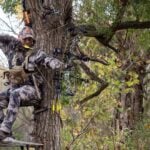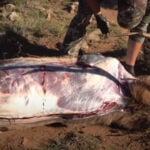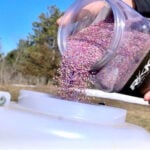While some hunters enjoy small handy binoculars that can fit into a shirt pocket others like binoculars that sit on a tripod and can really pull a distant object in close.
No matter which style of binocular you prefer there is no questioning the benefit that good optics can have on your bow hunting success.
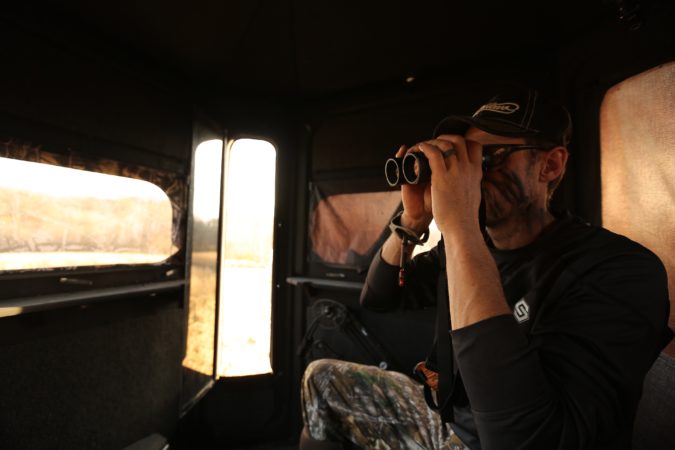
How Much Should You Spend?
Some folks like inexpensive optics because they beat them up and believe a $50 pair will get the job done. Then you have the optics snob who believes nothing but the most expensive glass will get the job done.
I tend to fall somewhere in the middle; opting for a pair of binoculars that won’t break the bank but also provide good clarity and light gathering.
No when it comes to optics there is no question you get what you pay for. Floyd Green knows a few things about optics. Green owns the Outdoorsman’s in Phoenix, Arizona.
The Outdoorsman’s is one of the top Swarvoski dealers in the entire country.
“In the East and Midwest, a mid-priced pair of optics will usually get the job done,” said Green. “Out West, on the other hand, high-quality optics are often needed when glassing for hours each day.”
Mid-priced and high-quality glass, even when being used for Midwest whitetail hunting and scouting, can make finding deer more enjoyable and more productive.
If you are in the market, realize the more money you have to spend the better.
What Magnification Should You Buy?
Before making a purchase you must first decide what you want, which isn’t always as cut and dry as you might think.
If you are mainly hunting from a treestand a pair of midsize binoculars like an 8×42 will probably do the trick.
If you like glassing fields or go out West every year a large 10×42 or 10×50 might be what you want.
I’ve noticed that many bowhunters purchase large optics only to leave them in the truck or at home when hunting because they don’t want to lug them around.
If that sounds like you, consider purchasing a small pair of binoculars like a 7×35 or 8×32 for the treestand and pickup truck.
You won’t be able to see a pimple on an elk butt three miles away, but they work well for checking out a corn field or glassing a buck in a food plot.
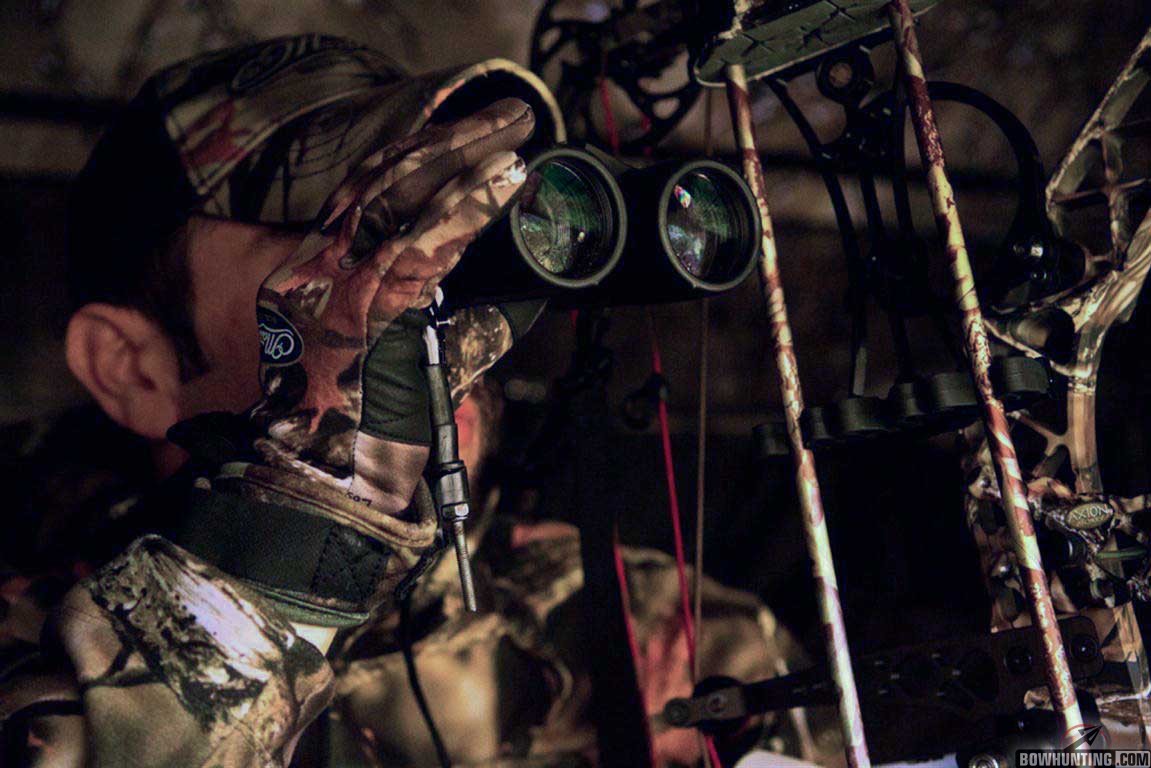
If you like to glass from a distance maybe you should consider a spotting scope. A 20x60x60 spotting scope can make a distant deer or elk look like they are right next to you.
If you do backcountry hunting having a spotting scope is always a good idea. The problem with a spotting scope is it can be heavy and bulky but if you plan on doing a lot of glassing it is worth the extra weight.
If you don’t like the bulkiness of a large spotting scope, consider a mini spotting scope like a 15x45x60.
I have used an Alpen mini spotting scope for years and love it. It can even be attached to my drivers’ window for easy scouting in the summer.
If you are really picky about remaining light weight and mobile maybe you should consider purchasing a monocular.
When most people are shopping for optics, they don’t think much about a monocular but I have learned that a monocular can be a great tool.
They are lightweight and compact. I currently have a monocular sitting on my mantle. I use it daily. When I hunt elk in the backcountry and hunt turkeys in the Midwest, I often use a monocular. It fits easily into my pack and is convenient to use. I like a 10×25.
At the end of the day it all boils down to fitting the optic to your style of hunting. If you are a treestand hunter, a small pair of binoculars is probably best. If you plann on spending long hours glassing open areas out West then high end glass is a must.
If you do a lot of long range scouting during the summer or late season a spotting scope may be just want you need.
Every type of optics has their place; make sure and choose optics that fits your lifestyle.
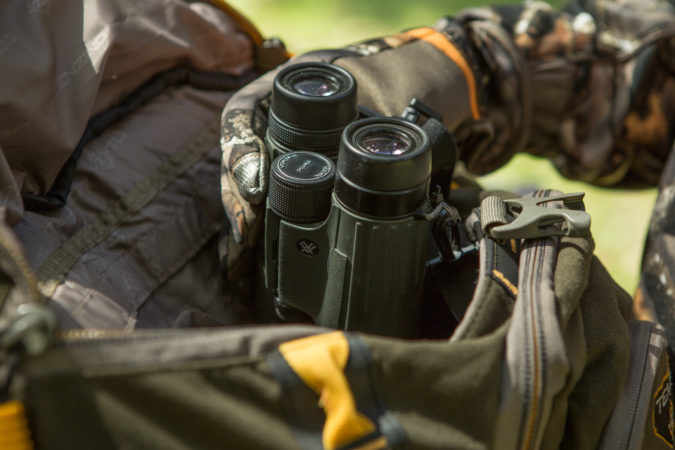
On another note, over the years I have discovered that although every hunter loves optics very few hunters really understand all the lingo associated with them.
I decided I would break down what all the lingo means so you can make an educated purchase when you go shopping. Below is a brief explanation of all the buzz words optics makers use.
FIELD OF VIEW
Field of view is very important when picking out a pair of optics. If you plan to scan lakes and fields in the Midwest, a standard FOV will do.
If you plan to hunt in the West, you may want to consider buying a pair of optics with a wide field of view. What is the difference between regular FOV and a wide FOV?
Field of view describes the number of feet you will be able to see per 1,000 yards of distance. The field of view for a standard 7* binocular would be 372 feet. If you purchase a pair that has wide angle lenses with something like an 8.2* FOV, it goes up to 487 feet.
The wider the angle, the more you see as you glass a cornfield or scan the side of a mountain in search of elk. If you hunt a lot, a wide angle lens may be worth the extra investment.
LENS DIAMETER
Lens diameter is essential as it controls the amount of light allowed to enter the lens. If the lens diameter is large more light will be able to enter and of course more light means a brighter image.
If you plan on doing a lot of glassing in the late evening or early morning (as most bow hunters do) consider buying a pair of optics that are 42mm or 50mm.
The drawback to having a large diameter lens is they are considerably heavier than a small diameter lens.
If you are backpacking in somewhere, you may want to get a smaller diameter lens like a 35mm which will be a smaller, more compact pair of binoculars that weigh almost nothing.
EYE RELIEF
Eye relief is something that needs to be considered when picking out a pair of binoculars, especially if you wear eyeglasses.
Eye relief is the distance expressed in millimeters from the eye piece lens to the point where the eye is positioned to view the entire image.
Eye relief is affected by magnification, the number of lens elements, and the field of view. Most binoculars provide 8-13mm of eye relief.
Binoculars with long eye relief provide 14-20mm of eye relief. If you wear eyeglasses, you will want a pair with long eye relief.
If you plan on glassing from the side of a mountain for long periods of time, you will also want long eye relief.
Without long eye relief, you may end up getting a headache which could last all day.
EXIT PUPIL
The exit pupil is something you don’t hear many hunters discuss around the campfire, but it’s something you should be aware of before making a purchase.
Exit pupil is the amount of light that is usable by a pair of binoculars or a spotting scope. The rule of thumb is the larger the exit pupil number, the brighter the image will appear especially as the sun dips behind the horizon towards the end of shooting hours.
Exit pupil is determined by dividing the diameter of the objective lens by the magnification.
For instance, a 7×35 binocular has an exit pupil of five. For general viewing, anything from 2.5mm to 4mm will work fine. If you plan on using your optics a lot during the evening hours, you will want something that is 4mm or higher.
An exit pupil of 5mm is generally viewed as the minimum for serious hunting situations.
RESOLUTION
Resolution is a measure of image clarity. The larger the diameter of the lens, the clearer the image will be. However, other factors play into how clear an image is.
The clarity of an image is obviously important and often, higher-end optics have a clearer image because the companies use higher-quality glass, coated lenses, and higher-quality prisms.
COATED OPTICS
The coating on a lens plays a key role in how clear an image is. Quality binoculars always have some form of coating on the lenses.
The very best optics are “Fully Multi-Coated.” Multi-Coated means all glass surfaces have multiple coatings on them to prevent glass surfaces from reflecting light or losing it.
Obviously more coatings are better and all high-end binoculars have multiple coatings.
If you are looking at a pair of optics that say they have been “fully coated,” it means that all air-to-glass surfaces have been coated with at least one layer of coating.
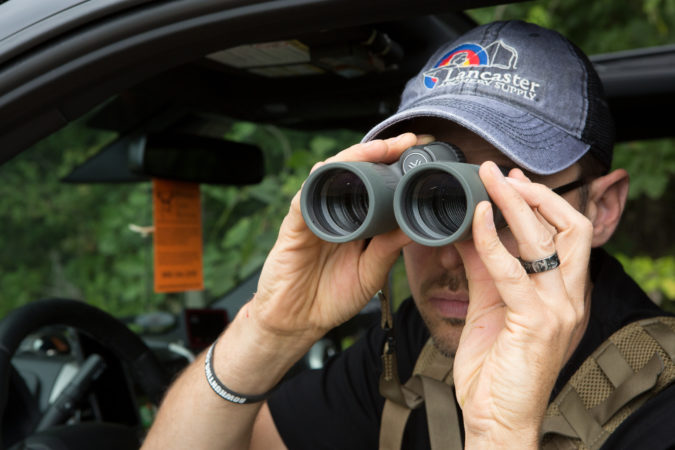
PRISMS
We hear a lot of discussion about prisms. But what are they? There are two types of prisms available in optics: roof prisms and porro prisms.
Porro Prism binoculars tend to be larger and have a unique body design. Roof Prism binoculars tend to be more straight and streamlined. Both types, if manufactured correctly, work well.

 By
By 